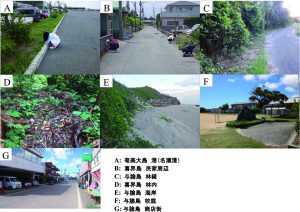Abstract / Introduction / Summary:

Forty seven ant species belonging to 23 genera in 5 subfamilies were collected from 7 habitat types on Amami Islands, Kagoshima Prefecture, south western Japan. Ants were sampled using honey or powder- cheese baiting, hand collecting, litter sifting, and soil sifting. In Yron-jima, 31 ant species were collected. On the other hand, only 9 species were collected in Amami-oshima. In this present study, 16 of 47 ant species collected in Amami Islands were alien ant species. Fifteen alien ant species were collected in Yoron-jima. In Amami- oshima, 8 alien ant species were collected. In subtropical rain forest, the most species were collected (30), following by ports (25), housing lots (24) and forest edges (21). The dominant ant species was estimated by frequency of occurrence to honey baits or powdered cheese baits. In port, dominant ant was Pheidole parva (0.50) in Naze Port (Amami-oshima), Paratrechina longicornis and Tetramorium bicarinatum (0.37 in each species) in Wan Port (Kikai-jima), Pheidole megacephalum in Hetono Port (Tokuno-shima) and Wadomari Port (Okinoerabu-jima) (1.00 and 0.90 in each port), Monomorium chinense in Kametoku Port (Tokuno-shima), China Port (Okinoerabu-jima) and Yoron Port (Yoron-jima) (0.50, 0.37 and 0.77 in each port). In all of honey baits (210) in 7 ports, the most dominant ant was P. megacephalum(0.40), following by M. chinense (0.37), P. parva (0.19), T. bicarinatum (0.11) and P. longicornis (0.10). In the forest, the dominant ant was Pheidole noda (0.90) in Kikai-jima, Nylanderia ryukyuensis, Pristomyrmex punctatus (0.40 in each species) in Okinoerabu-jima, Monomorium intrudens in Yoron-jima. In all of powdered cheese baits (90), the most ant species was P. noda (0.34), following by M. intrudens (0.30), N. ryukyuensis (0.26), N. amia (0.24) and P. pieli (0.17).
